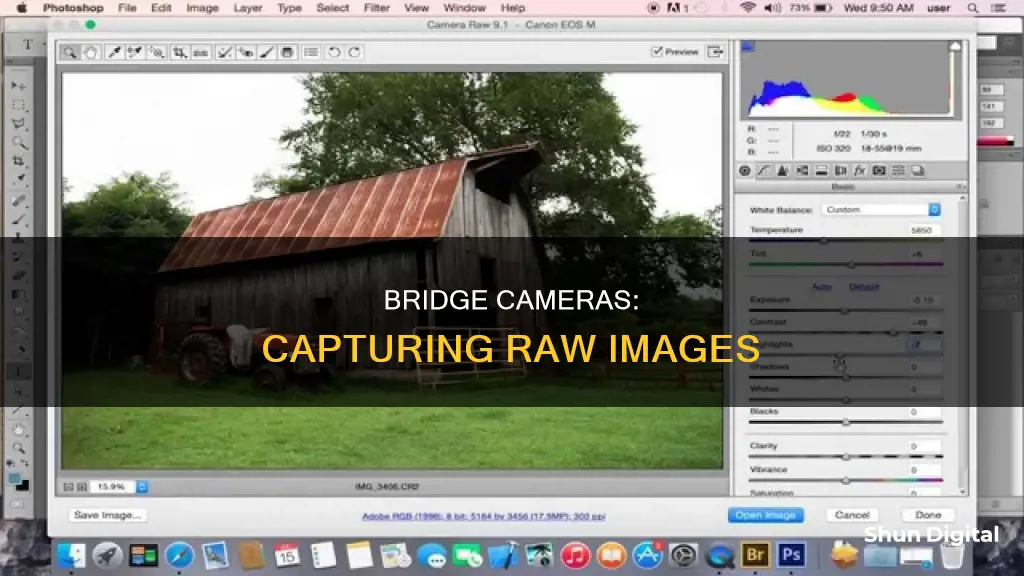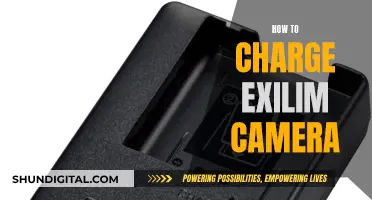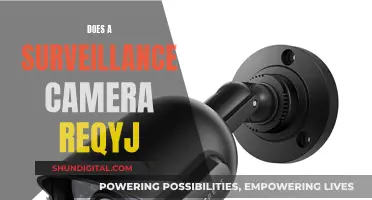
Bridge cameras are a good choice for photographers who want a zoom range that would otherwise require carrying several lenses along with an SLR. They are also a convenient option for those who want a lot of zoom range in an all-in-one package. While their smaller sensors don't offer the same image quality as crop sensor and full-frame cameras, they combine the simple usability of point-and-shoot cameras with an incredible zoom range.
Several bridge cameras offer the ability to shoot in RAW. RAW image files contain minimally processed data from the image sensor, resulting in less loss of image quality and more room for post-processing.
Some of the best bridge cameras that support RAW shooting include the Panasonic FZ2500, Sony RX10 IV, and Panasonic FZ1000 II. The Nikon Coolpix P950 and Canon PowerShot SX70 HS are also great options, offering RAW shooting and powerful zoom capabilities.
| Characteristics | Values |
|---|---|
| Top Bridge Camera | Panasonic FZ2500 |
| 2nd Best Bridge Camera | Sony RX10 IV |
| 3rd Best Bridge Camera | Panasonic FZ1000 II |
| Best Entry-Level Bridge Camera | Canon PowerShot SX70 HS |
| Best Superzoom Bridge Camera | Nikon COOLPIX P1000 |
| Best Mid-Range Bridge Camera | Panasonic LUMIX FZ1000 II |
What You'll Learn

Sony RX10 IV
The Sony RX10 IV is a high-end bridge camera that delivers an unmatched combination of mobility and speed for imaging enthusiasts and professionals looking for the ultimate 'all-in-one' solution. It features the world's fastest autofocus acquisition time of 0.03 seconds, a 24-600mm F2.4-4 ZEISS Vario Sonnar T lens, and continuous shooting of up to 24fps with AF/AE tracking.
The camera is equipped with a 1" stacked Exmor RS CMOS sensor with a DRAM chip, which enhances efficiency and speed and allows for stunning 20.1-megapixel images. The BIONZ X image processing engine further improves image quality by enhancing resolution, minimizing noise, and reproducing reality in all its variety and subtlety.
The RX10 IV also offers 4K movie recording with full pixel readout and no pixel binning, ensuring footage with resolution high enough to satisfy professionals. The camera's Super Slow Motion feature has been enhanced, with maximum shooting durations of up to 4 seconds in Quality Priority mode and 7 seconds in Shoot Time Priority mode.
In terms of design, the RX10 IV has an easy-to-hold handgrip, a tilting LCD screen, and a Tru-Finder XGA OLED viewfinder with a high-resolution organic EL device. It also features built-in Wi-Fi, image stabilization, an articulating screen, and face detection.
Overall, the Sony RX10 IV is an impressive bridge camera that offers a versatile range of features and exceptional image and video quality, making it a great choice for nature and wildlife photography, as well as travel and everyday use.
Charging the Lytro Camera: A Step-by-Step Guide
You may want to see also

Panasonic Lumix FZ1000 II
The Panasonic Lumix FZ1000 II is a bridge camera with a 1-inch 20.1-megapixel High Sensitivity MOS Sensor and a 16x optical zoom lens, offering an equivalent of 25-400mm. The camera is designed to appeal to holidaying photographers who want to travel light. It is an incremental upgrade from the original FZ1000, with the same sensor, processor and lens.
The FZ1000 II delivers solid all-around performance and its long zoom lens gives you the versatility to shoot far-off subjects and wildlife, capture everyday moments, or zoom in for close-ups. The camera is not too portable but feels well-built and comfortable to use. It has a fully articulated touchscreen, which lets you monitor yourself while recording. It also does a great job of stabilising camera shake in FHD while walking at a moderate pace, although stabilisation isn't as good in 4k.
The FZ1000 II has a quick start-up time and an ultra-fast autofocus of approximately 0.09 seconds. It has a burst rate of 12fps and high-speed (electronic) shutter speed of 1/16000 seconds. It can shoot video in 4k or FHD, although it's best suited to shooting FHD video, as its autofocus and stabilisation features perform significantly worse in 4k.
The FZ1000 II has a recommended retail price of £769.99 (UK) / €849.99 (Ireland) / $899 (US).
Importing Camera Raw Files into Adobe Premiere: A Step-by-Step Guide
You may want to see also

Canon PowerShot SX70 HS
The Canon PowerShot SX70 HS is a bridge camera with a powerful 65x optical zoom lens, a 20.3-megapixel CMOS sensor, and a DIGIC 8 image processor. It features a 0.39-type OLED electronic viewfinder with approximately 2.36 million dots and offers 4K video and 4K time-lapse recording capabilities.
The camera's compact and lightweight design makes it a good option for everyday use and travel, weighing 600g and measuring 5 x 3.6 x 4.6 inches. It has a wide-angle lens with a minimum shooting distance of 0cm, allowing for impressive close-up macro shots. The camera also features built-in Wi-Fi and Bluetooth connectivity for easy sharing.
The Canon PowerShot SX70 HS offers a range of shooting modes, including automatic, movie, panorama, and portrait, as well as various white balance and flash settings. It has a continuous shooting speed of up to 10 fps and supports memory cards up to SDXC (UHS-I).
The camera's autofocus system has received mixed reviews, with some users praising its speed and performance, while others have found it challenging to achieve sharp focus. The image quality has also received mixed feedback, with some users noting that the pictures often lack sharpness and have muted colors.
Overall, the Canon PowerShot SX70 HS is a versatile and easy-to-use bridge camera, ideal for those seeking a lightweight option with a powerful zoom lens. While it may have some limitations in low-light conditions and autofocus performance, it offers good value for the price and is a popular choice for nature and wildlife photography.
Camera Battery Drain: Which Device Kills It Faster?
You may want to see also

Nikon Coolpix P1000
The Nikon Coolpix P1000 is a bridge camera with a unique 125x zoom lens, allowing for a maximum equivalent focal length of 3,000mm. This is the longest zoom range on the market for a bridge camera, making it a great choice for those who want to capture extremely distant subjects without the bulk of a super-telephoto lens. The camera features a 16MP 1/2.3" CMOS sensor, 4K UHD video recording, and RAW image capture.
The P1000 is a large and heavy camera, weighing approximately 2lbs, and measuring 5.8 x 4.7 x 7.2 inches. Despite its size, it is still more portable than a DSLR with a super-telephoto lens and is a good option for those who want to travel light. The camera features built-in Wi-Fi and is compatible with the Nikon SnapBridge app, allowing for easy image transfer to a smartphone.
The P1000 offers full manual controls along with easy auto shooting. It has a top continuous shooting speed of up to 7 frames per second and features a dual detect image stabilization system, which helps to ensure sharp images and smooth videos. The camera also includes a variety of creative modes, such as time-lapse and super-lapse shooting.
The Nikon Coolpix P1000 is an excellent choice for those who want an all-in-one camera with an extreme zoom range. It is particularly well-suited for birding, sports, wildlife photography, and travel photography. While the camera has some limitations, particularly in low-light situations, it is a versatile and capable option for those who want the convenience of a bridge camera with the flexibility of a super-telephoto lens.
Understanding Camera Battery Ratings: A Quick Guide
You may want to see also

Panasonic Lumix FZ80
The Panasonic Lumix FZ80 is a bridge camera that offers plenty of value for its price. It features a powerful 18.1-megapixel MOS sensor, a 60x zoom DC Vario lens (20-1220mm) with a super bright F2.8-5.9 aperture range, and Panasonic's Power O.I.S. (Optical Image Stabilizer) technology. The camera has a high-resolution 1,170K-dot viewfinder and a rear touch-enabled 3-inch LCD display that remains clear even in bright sunlight.
In terms of video capture, the FZ80 supports 4K QFHD video recording (3840 x 2160) and offers three unique 4K ultra HD video pause and save modes, allowing you to extract individual high-resolution photos from 4K ultra HD video filmed at 30 frames per second. The camera also performs well in low-light conditions, allowing you to capture impressive images in dimly lit environments.
For connectivity, the FZ80 provides USB charging and Wi-Fi connectivity to your mobile device, as well as HDMI D, Micro USB, and USB 2.0 ports for additional connectivity to other devices. Overall, the Panasonic Lumix FZ80 is a great budget option for those seeking a bridge camera with versatile features and strong performance.
Wireless Cameras: Charging Methods and Innovations
You may want to see also
Frequently asked questions
Many bridge cameras shoot in RAW, including the Panasonic FZ2500, Sony RX10 IV, Panasonic FZ1000 II, Panasonic FZ200, Canon SX60, and Nikon Coolpix P950 and P1000.
A RAW image file contains minimally processed data from the image sensor, resulting in less loss of image quality and more room for post-processing.
Shooting in RAW gives you more flexibility in post-processing, allowing you to adjust settings like white balance, sharpening, and colour balance. RAW files also yield better image quality and more flexibility than JPEGs.
Yes, RAW files tend to be much larger in size compared to JPEGs, which means cameras take longer to save images and memory cards hold fewer shots. Shooting in RAW also adds an extra step to the photographer's workflow, as RAW files need to be processed and turned into a different format before use.







